A Time Blocking Comparison: Sunsama vs. Fantastical
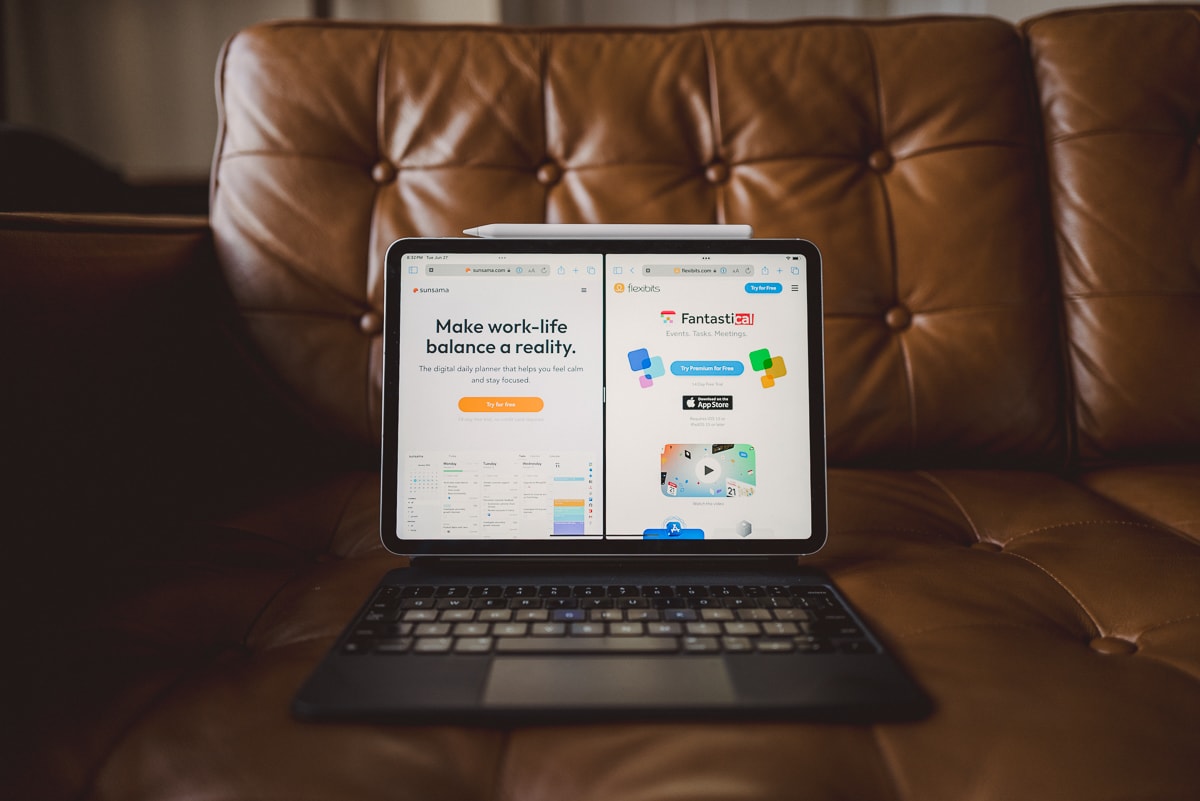
Habits change. Inspiration comes and goes. Workflows spring up and taper off. But for me, time blocking never changes. Time blocking has become fundamental to my work day, ensuring I have chunks of time to complete tasks and ensuring my colleagues know what I’m up to. Time blocking structures my day. Time blocking blocks out extra meetings. Time blocking pushes me forward.
I’m not sure if one could say there are many forms of time blocking. By and large, time blocking consists of putting tasks into your calendar with a time duration for completion. To my knowledge, nearly all forms of time blocking consist of tasks — rather than events — building out your calendar.
But some apps do structure various parts of the time blocking workflow differently. Today, I’m hoping to discuss the two apps I have the most experience with on the Mac: Sunsama and Fantastical. These are very different apps — one is a full-on productivity app with many productivity features; the other a calendar app on steroids. However, both have succeeded for me in some shape or form and both have fallen flat in other facets.
Many may not even consider Fantastical a productivity app at all. Recent updates have me thinking otherwise, though — you can now quickly drag and drop tasks into your calendar and use natural language parsing to set a duration for the task. Those tasks sync over to the built-in Reminders app or Todoist, providing integration with other productivity apps. And Fantastical also provides excellent meeting scheduling features. Think Calendly, but in a Fantastical style. Overall, I think Fantastical is right at home in any time blocking conversation.
To me, there are three major stages to a time blocked day:
- Planning your day
- Working through your day
- Reviewing your day
Sunsama and Fantastical both play a role in all three stages, but differently.
Without further ado…
Planning
The planning stage for me consists of sitting down, looking at all my task silos, and building out a day to work on the most important items. I aim to complete this in 15 minutes or less. Some days I prefer granularity and specificity (“reply to this email”) and some days I prefer generalities (“email”).
Sunsama’s Planning Features
Sunsama does an incredible job helping you plan out your day. Each morning, Sunsama pings you with a reminder to build out your day. The planning process works in the following order:
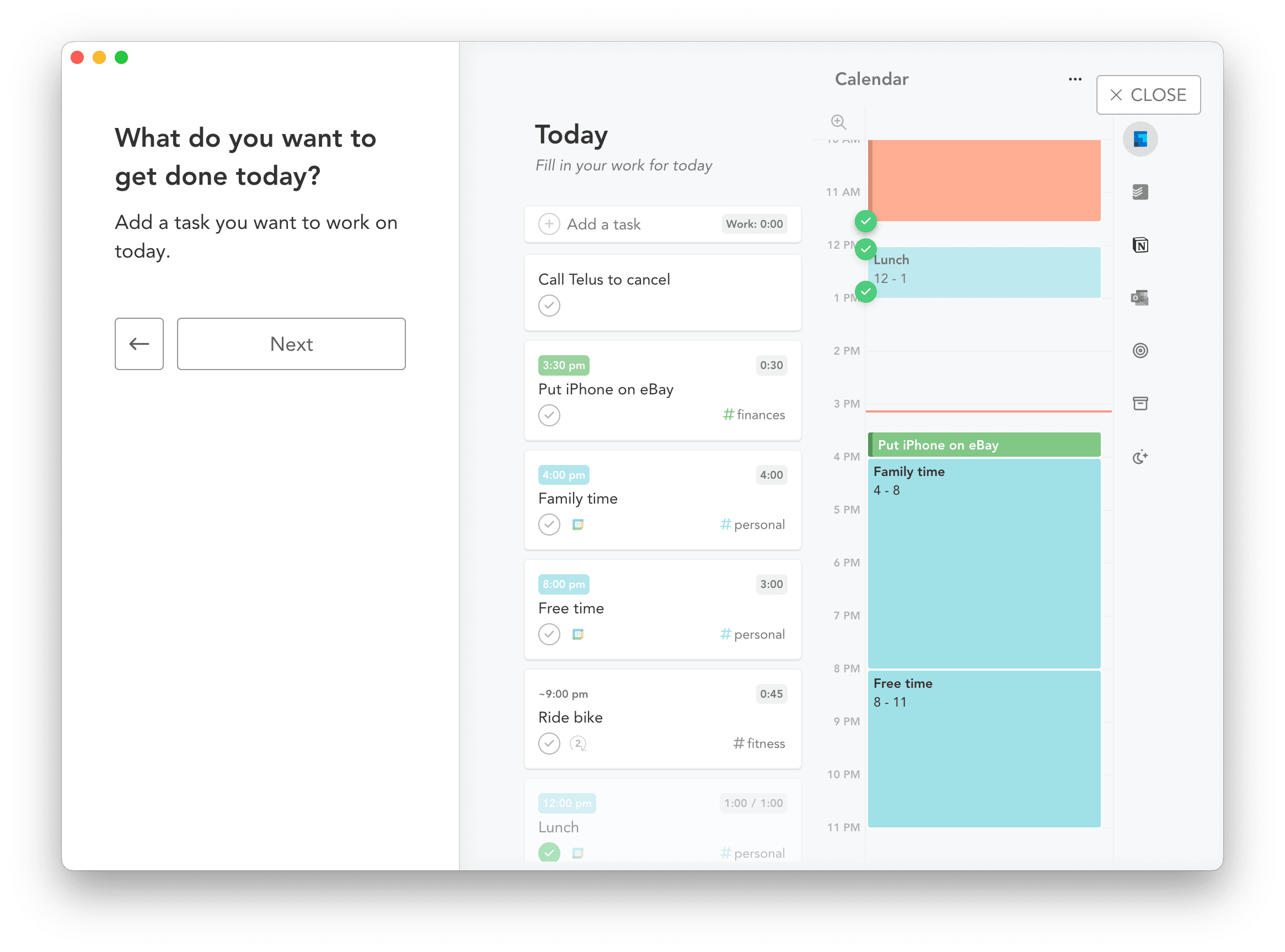
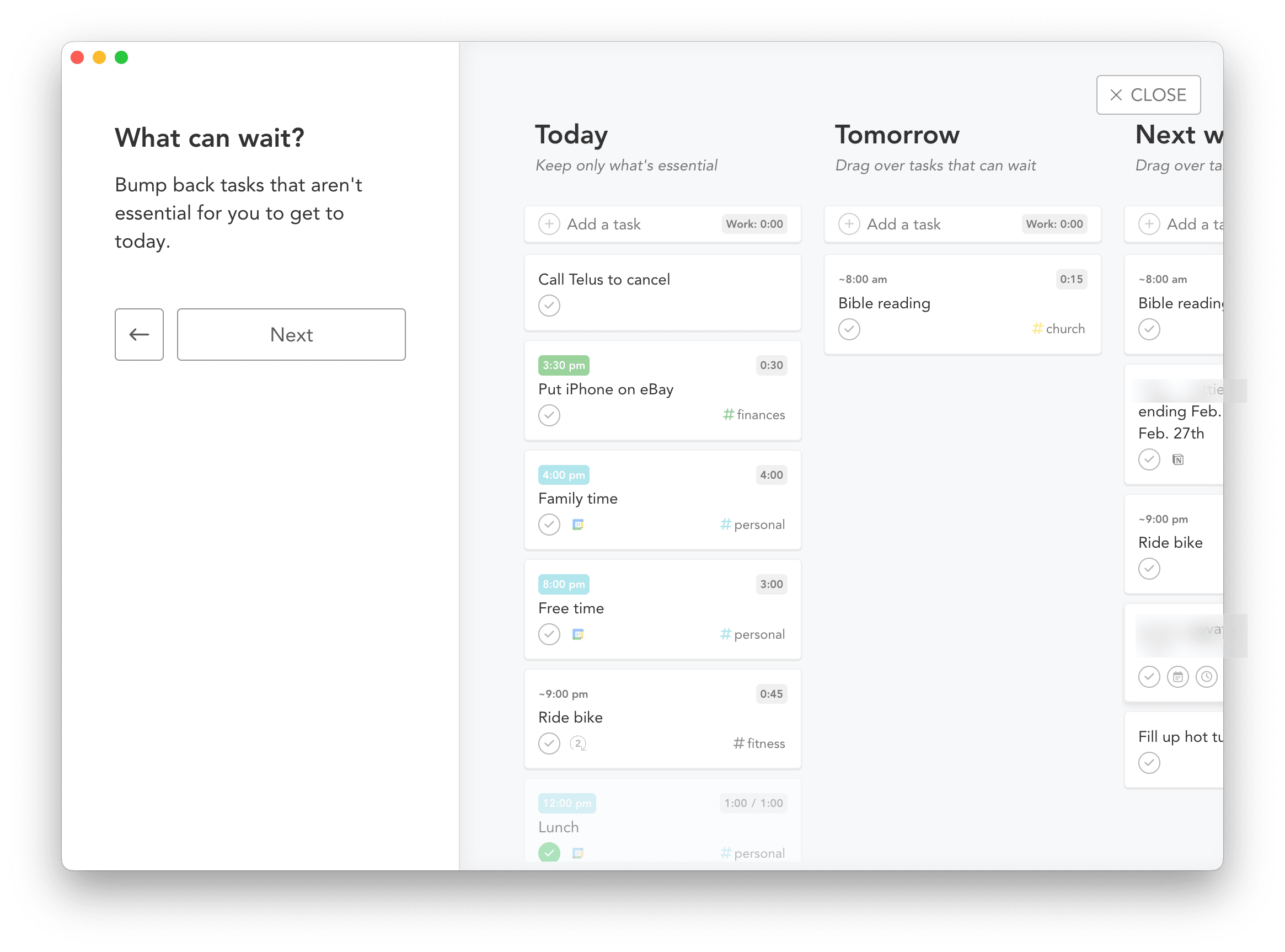
- What do you want to get done today?
- How long will each thing take you to complete?
- What can wait for another day?
- How do you want the most important tasks structured in your calendar?
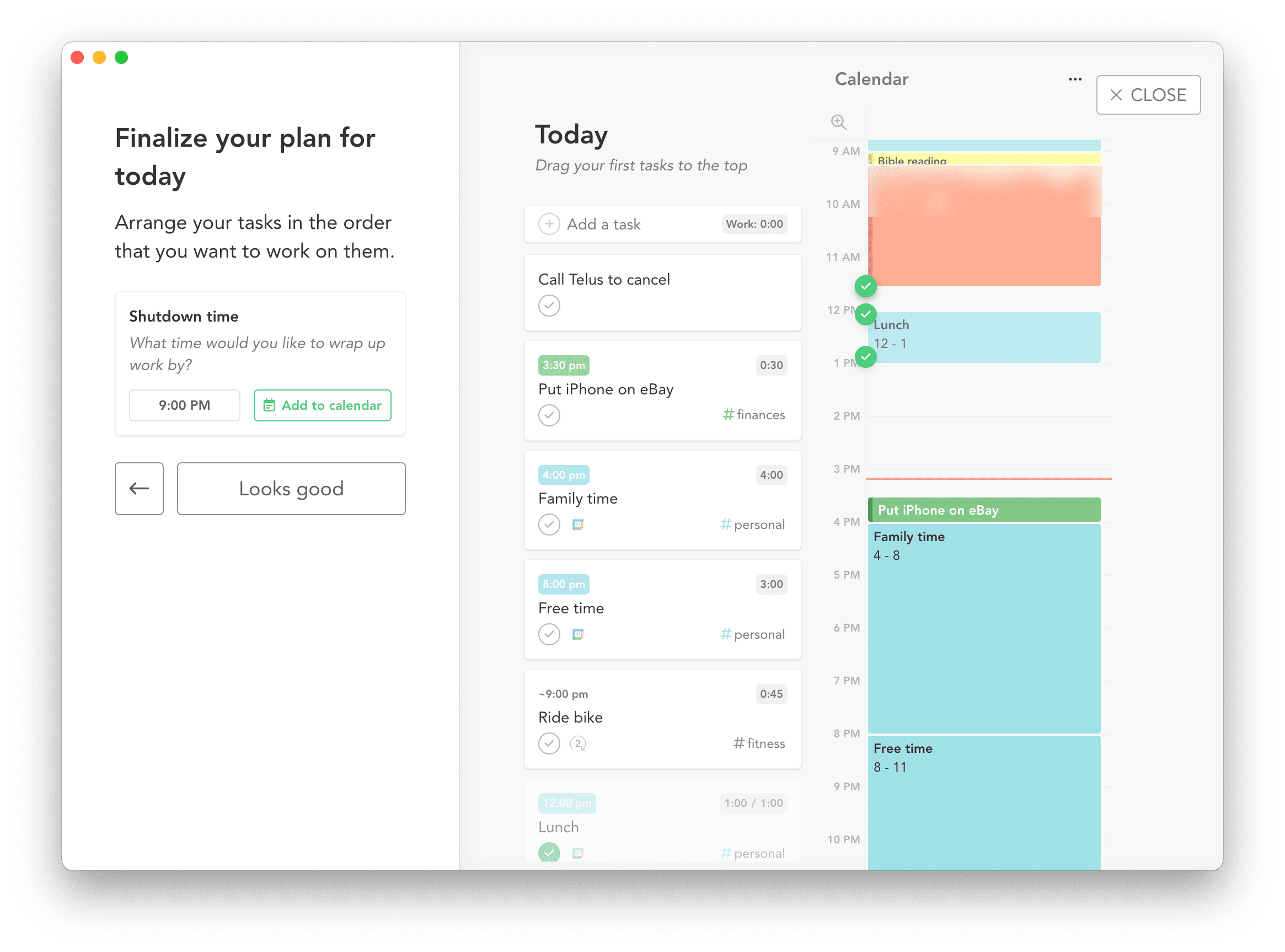
Sunsama rocks in the planning department. You can quickly drop all tasks you want to complete in a day in step #1. This is effectively your “Inbox” of tasks. Sunsama also integrates with Notion, Todoist, Clickup, Github, Exchange, Gmail, and more, ensuring you can actually bring in your emails and other tasks from a wide variety of apps all at once. This first step is basically the ultimate productivity inbox.
Once done, you can also tag your tasks “Work” or “Personal”, set an estimated duration time, and add any other notes to build out the task’s context. This can become quite granular and can take some time if you have many shorter duration tasks.
In step #3, you can defer the less important tasks to a future date.
In step #4, you can use some automation features by clicking a certain key to automatically build out your calendar based on the duration of each task created in step #1. Sunsama ties a tag (“work” or “personal”) to the calendar of your choice. This effectively creates a unique calendar event for each task you add in step #4 — perfect for notifying your colleagues what you’re up to each day.
Fantastical’s Planning Features
Fantastical doesn’t have a built-out planning workflow of any sort. There are no queues to sit-down and tackle your day. There are no task silos or multiple inboxes to bring in everything you want to do into one specific list. There are no pings or notifications to get you off on the right track.
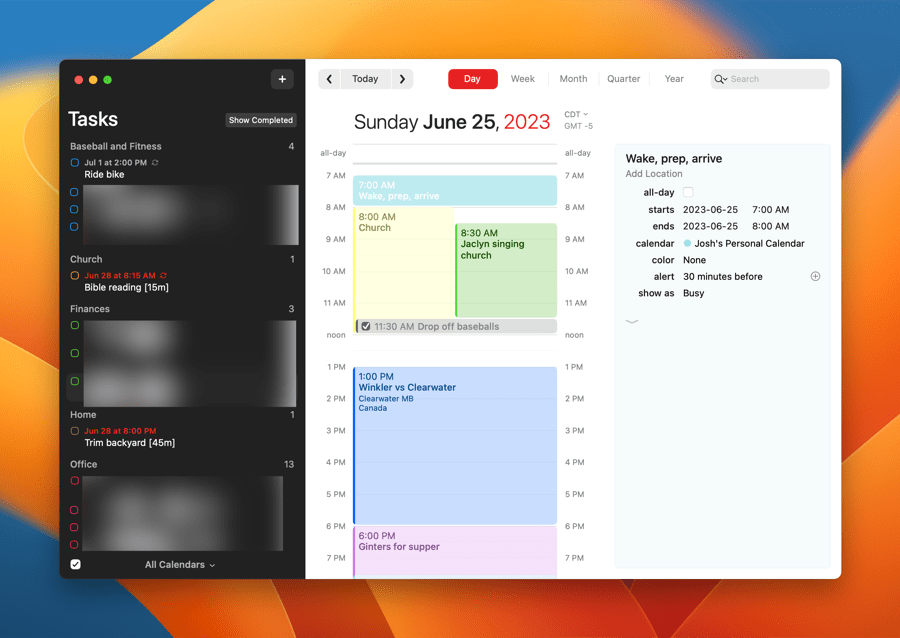
However, since Fantastical integrates nicely with the Reminders app — which itself integrates with a few other apps on the iPhone, iPad, and Mac — you can still build out a planning workflow in Fantastical.
My planning workflow involves Spark (my email app), Reminders, and Fantastical. I tend to swipe important emails over from Spark to Reminders, which nicely show up inside Fantastical’s “Tasks” section.
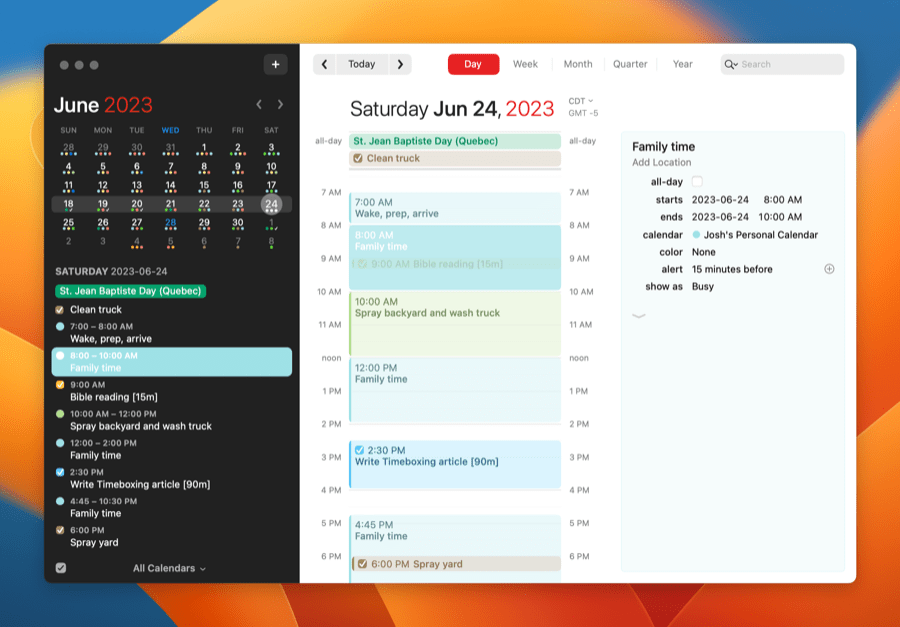
From there, I can drag specific emails and tasks right into my calendar. Each task adds a default event with a default duration in your calendar, but you can quickly edit this by stating the number of minutes you expect the task to take by adding “[15m]” or “[120m]” to the task. Fantastical will then update the duration of the time block automatically.
The biggest hiccup for me with Fantastical’s planning process is the fact that time blocked tasks do not become calendar events. This means my colleagues can’t see what I’m doing during the day. If I need to block out time to notify my colleagues what my plans are, I’ll have to create a second generic time block within a calendar. This duplicates some of the planning work.
Action
As you work through the day, you’ll have to return to your productivity app to check in on your progress, mark tasks completed, and make changes to your plans. Again, Sunsama and Fantastical are very different in this regard.
Sunsama’s Time Tracking Features
Sunsama has two specific time tracking features some users will love:
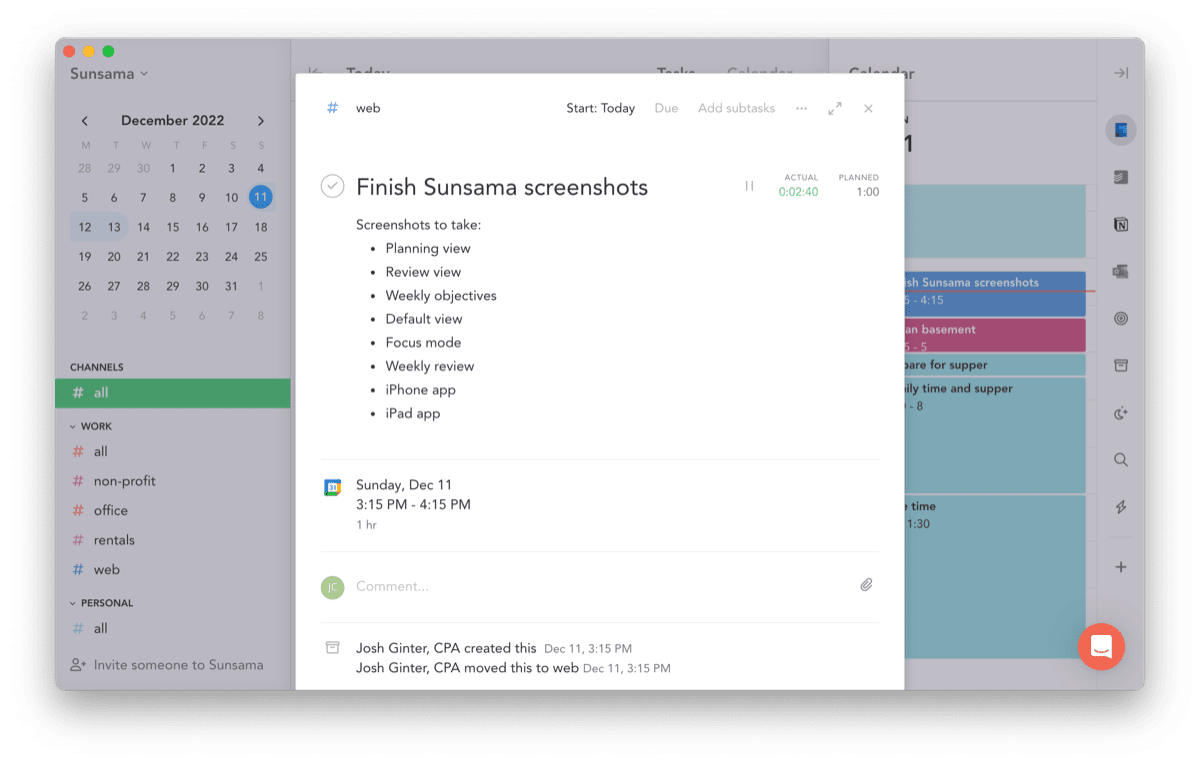
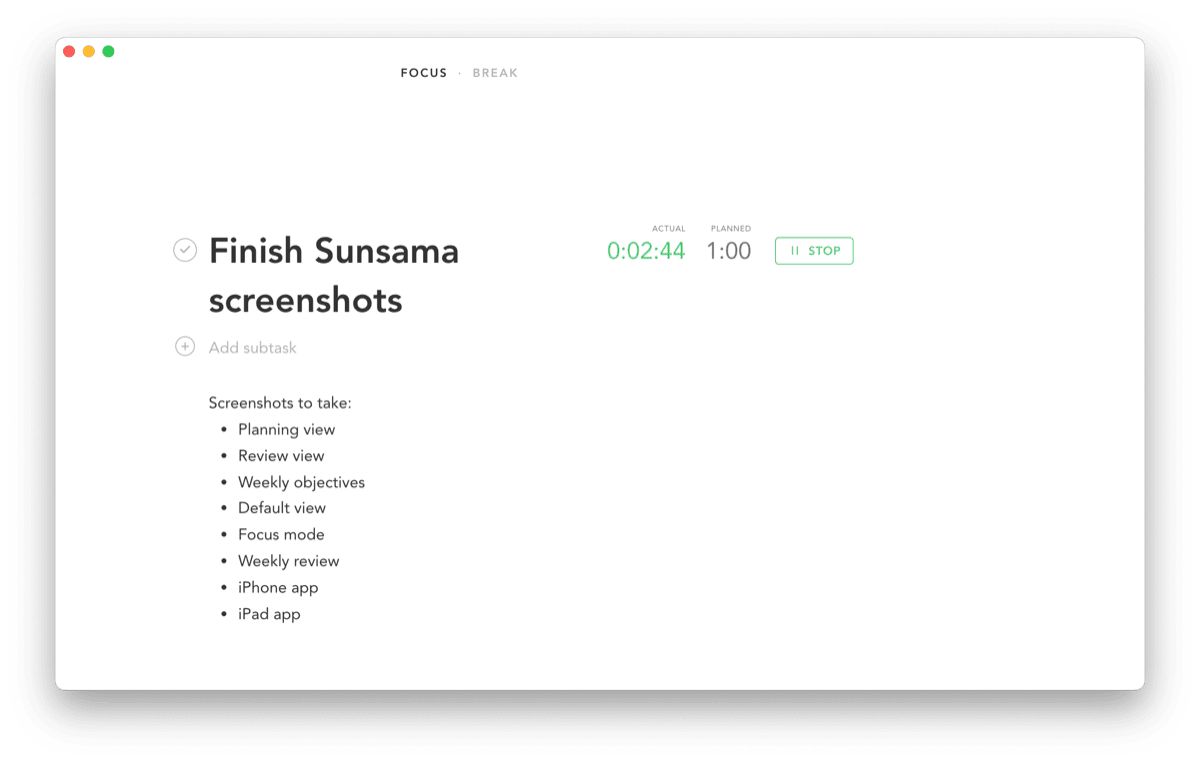
- Actual time tracking, i.e. tap the space bar to begin a task and track to the second how long it takes you to complete.
- Less specific time tracking, where you notify Sunsama how long it took you to complete a task after finishing.
The first method provides an extra area to store notes as you work through the task. This works great for writing meeting minutes and referencing any other notes you added to the task when you planned out your day.
The second method is ideal for folks who get interrupted throughout the day and forget to toggle the task’s timer. This is definitely where I fall — instead of tracking down to the minute, I complete a task and mark how long it took me to complete, generally with a round estimate to the 15 minute mark.
Tracking time in Sunsama is fundamental to the last stage of time blocking: review.
Fantastical’s Ease of Use
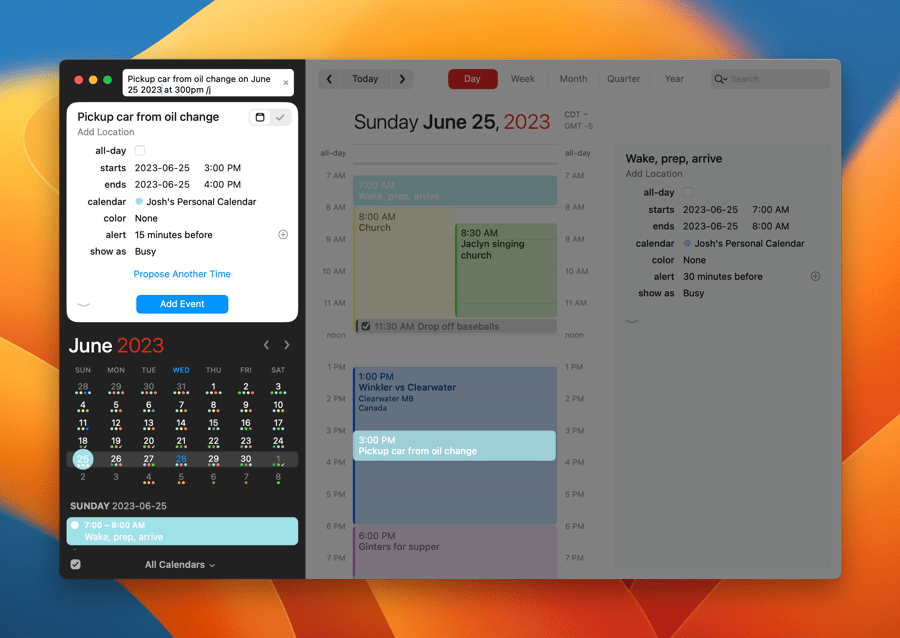
Fantastical is king at capturing events and tasks throughout the day via its natural language parsing field. Simply typing task Pick up car from oil change at 3:00PM [15m] will create a 15-minute time blocked task at 3:00PM to pick up the car from the oil change. This is ideal for capturing new tasks and events throughout the day.
However, there aren’t any specific time tracking features baked into Fantastical at this point. Jumping in and out of the app is pretty easy and you can check off tasks in any calendar view or the Tasks list view in the left sidebar. If you want to be more specific about how long it took you to complete the task, you can change the “[15m]” moniker in the title of the task to the amount of time it actually took you. You won’t be able to review the difference between your planned duration and your actual duration this way, but it certainly helps in the review stage of your time blocked day.
Review
Finally, the review stage. What good is all this planning if you can’t go back, review, and learn from your mistakes? Reviewing each time blocked day can be important in different ways — you can review to ensure you don’t miss any billable time, you can review to determine if your expectations aren’t matched with reality, and you can review to provide a jumpstart to your next day’s plans. No matter the reason, review is fundamental to good time blocking.
Sunsama’s Built-In Review Process
Sunsama’s review process isn’t as built out as its planning process, but it’s still great.
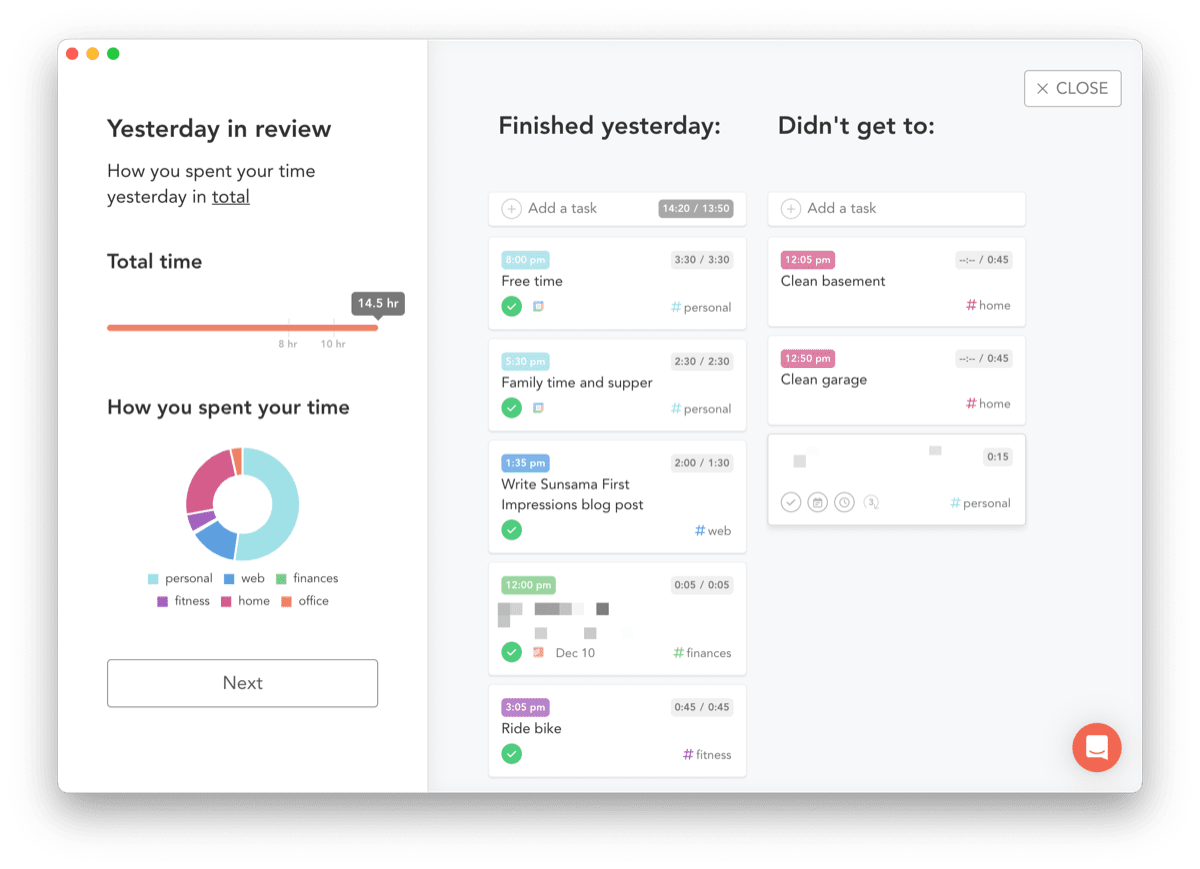
When your day is about to wrap up — which can be set to any time you want — Sunsama will allow you to work through the shutdown routine. The shutdown provides analytics, breaking down how much time you spent working on work and personal tasks and which tasks you completed. There’s also an opportunity to write out your thoughts on the day and post those thoughts to Slack.
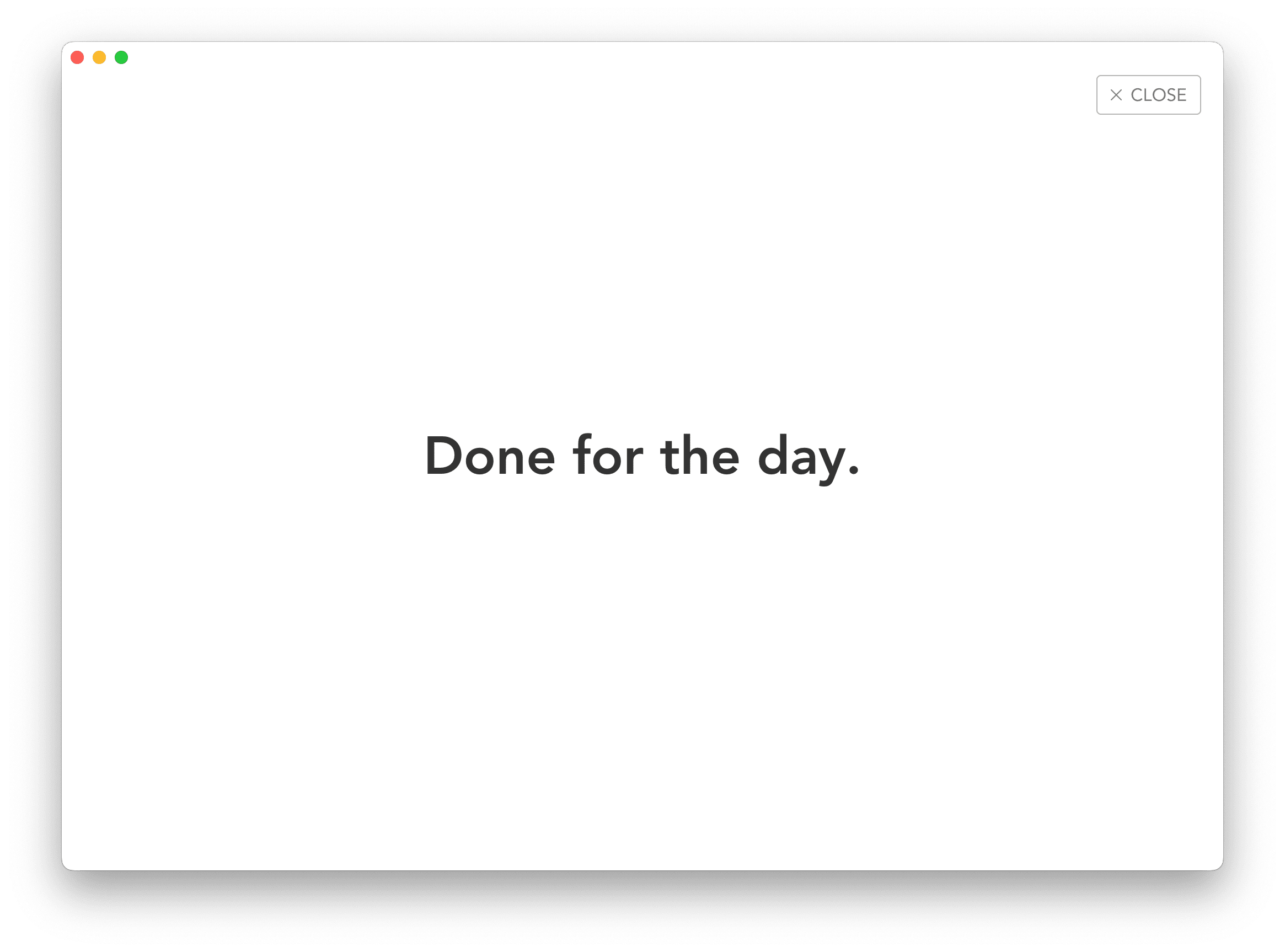
More than anything though, the shutdown routine in Sunsama triggers and somewhat forces you to step back from your computer. When it’s time to be done for the day, Sunsama can force you to be done for the day. If you’re aiming for a better work-life balance, Sunsama is certainly trying to do its part.
You can read more about Sunsama’s startup and shutdown processes in our article right here.
Fantastical’s Review Process
Just like the prior two stages, Fantastical doesn’t have a specific shutdown or review process. You can, however, ensure you have a shutdown routine through a few more manual ways.
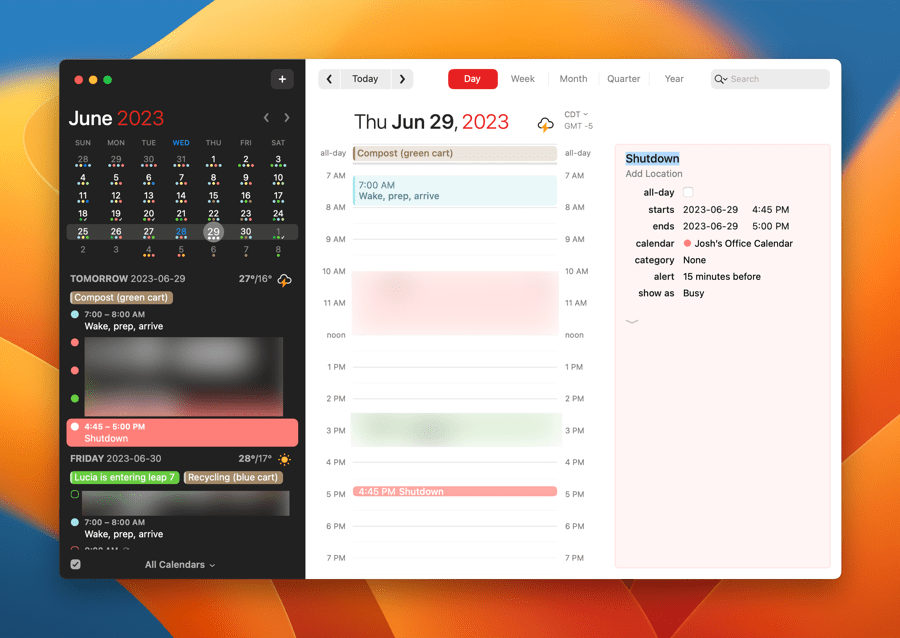
First, I tend to create blocks at the beginning of my day labelled “Wake, prep, and arrive” and at the end of my day titled “Shutdown”. Both of these can be very easily created using a shortcut in the Shortcuts app, which you can trigger from anywhere in iOS or macOS. Once created, you have your day’s start and end times. This shutdown time block ensures you have the time you need to review your day and move into the next one.
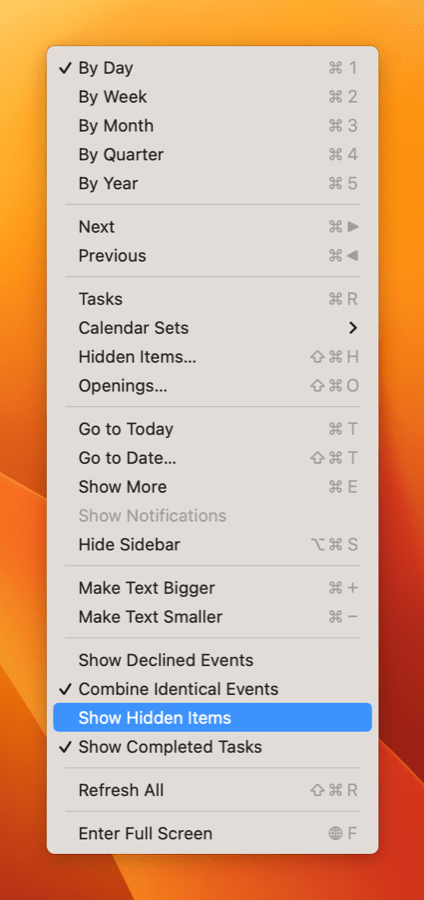
Second, if you change the number of minutes for each planned task to the number of minutes for actual time taken to complete the task, you can review your day pretty easily in either of Fantastical’s Day or Week views. To view completed tasks, you’ll have to jump into the View menu and select Show Completed Tasks. Otherwise, completed tasks will disappear off your calendar. If you change that duration when you finish a task, you should be able to quickly tell where your daily plan went awry.
Wrap Up
Can you tell? Indeed, Sunsama is built for time blocking. In each of the above three steps, Sunsama has a feature or workflow to work through each day. Fantastical’s time blocking features are quite new, meaning any time blocking routines you want to use inside Fantastical will be more manual by nature.

And this is fine — some folks may find Sunsama’s built-in routines to be too stringent and structured. You may find Sunsama to be too granular — each individual email and individual task has to be added to your calendar, creating the potential for a calendar littered with short events throughout the day and constant need to interact with Sunsama as you work through your task list. Some folks may prefer the generalities and manualness Fantastical provides in these regards.
Or, planners will be planners — some folks will adore the top-to-bottom planned approach Sunsama provides.
You do ultimately pay for the specific Sunsama routines. There’s a price difference between these two apps, to be sure. For those who have endless buckets of tasks, Sunsama’s monthly cost will be a bargain. For those who either have better control of their buckets or want a more general approach to time blocking, Fantastical’s cost may be easier to stomach.
Hopefully the above breakdown provides two options on opposite ends of the time blocking spectrum to help build out your daily calendar.
Productivity Focus Booster 🚀 Simplify and update your task management
If your to-do list overfloweth and you have multiple areas of life to manage, it’s time to get a system that actually works.
Get complete access to all the frameworks, training, coaching, and tools you need to organize your daily tasks, overcome distractions, and stay focused on the things that count (starting today).
Step 1: Refresh → Audit and streamline your current tools and systems and get clear on what’s working for and against you.
Step 2: Upgrade → Build a productivity system that plays to your strengths (even if you find “systems” annoying).
Step 3: Nurture → Make your system stick. Create a flywheel that keeps you focused on what matters most day after day.
Get all this, and more, inside the Focus Club membership.
Join 300 focused members who have access to $5,000 worth of our best courses and masterclasses, the Digital Planner, a Private Chat Community, Monthly Coaching Calls, and much, much more…
